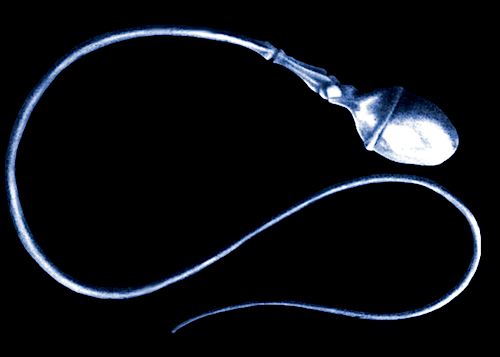|
|
Developmental Biology - Fertilization
New Factor Identified That Fuses Sperm to Egg
Researchers in Japan identify a new factor in orchestrating egg fertilization...
Fertilization is a fundamental process in sexual reproduction when the combination of male and female gametes blends genetic material to create a new unique individual. Now, Researchers in Japan have identified a new factor that may help orchestrate this vitally complex event.
In a recent study, researchers from Osaka University and Baylor College of Medicine have identified a novel protein that takes part in sperm-oocyte membrane fusion during fertilization, and named it Fertilization Influencing Membrane Protein (FIMP).
The human body is made up of trillions of cells, all derived from a single fertilized ovum. Sperm-oocyte fusion is a critical event in mammalian fertilization and three proteins that facilitate this are known.
The sperm membrane protein IZUMO1 was discovered in 2005 by this research team and named for a Shinto shrine celebrating marriage. Its counterpart, the oocyte membrane protein JUNO discovered nine years later was named after the Roman goddess of fertility.
Together they interact to form a protein complex, with the oocyte tetraspanin protein CD9 contributing. As three proteins cannot explain the complex molecular interactions involved, the search was on for other factors.
"We focused on the testis-specific 4930451I11Rik gene using CRISPR/Cas9-mediated genome editing technology to generate mutant 'knock out' mice with selectively inactivated or 'turned off' genes. Although IZUMO1 was present in 4930451I11Rik knockout spermatozoa, they were unable to fuse with oocytes and the KO males proved severely subfertile."
Yoshitaka Fujihara PhD, Associate Professor, Research Institute for Microbial Diseases and lead author of the study.
The 4930451I11Rik gene encodes two protein variants, a transmembrane (TM) isoform and a secreted isoform. CRISPR/Cas9-mediated deletion and transgenic rescue showed that only the TM isoform is essential for sperm-oocyte fusion.
Researchers named the TM isoform 'Fertilization Influencing Membrane Protein' clarifying that it is essential for fertilization, functioning in membrane fusion through a different pathway or stage from IZUMO1. Fluorescence mCherry tagging localized FIMP to the sperm equatorial segment where sperm-oocyte fusion occurs.
"Our findings support a potential role of human FIMP in sperm function. Further studies are needed to examine the cause of male infertility in Fimp knockout mice and to clarify the interaction of similar type I transmembrane proteins localized on the sperm head. This knowledge could be used to develop novel in vitro and in vivo infertility treatments as well as non-hormonal male-specific contraceptives."
Professor Masahito Ikawa, co-discoverer of IZUMO1 and senior author.
The research is published in PNAS, the Proceedings of the National Academy of Sciences.
Abstract
Sperm–oocyte fusion is a critical event in mammalian fertilization, categorized by three indispensable proteins. Sperm membrane protein IZUMO1 and its counterpart oocyte membrane protein JUNO make a protein complex allowing sperm to interact with the oocyte, and subsequent sperm–oocyte fusion. Oocyte tetraspanin protein CD9 also contributes to sperm–oocyte fusion. However, the fusion process cannot be explained solely by these three essential factors. In this study, we focused on analyzing a testis-specific gene 4930451I11Rik and generated mutant mice using the CRISPR/Cas9 system. Although IZUMO1 remained in 4930451I11Rik knockout (KO) spermatozoa, the KO spermatozoa were unable to fuse with oocytes and the KO males were severely subfertile. 4930451I11Rik encodes two isoforms: a transmembrane (TM) form and a secreted form. Both CRISPR/Cas9-mediated TM deletion and transgenic (Tg) rescue with the TM form revealed that only the TM form plays a critical role in sperm–oocyte fusion. Thus, we renamed this TM form Fertilization Influencing Membrane Protein (FIMP). The mCherry-tagged FIMP TM form was localized to the sperm equatorial segment where the sperm–oocyte fusion event occurs. Thus, FIMP is a sperm-specific transmembrane protein that is necessary for the sperm–oocyte fusion process.
Authors
Yoshitaka Fujihara, View ORCID ProfileYonggang Lu, View ORCID ProfileTaichi Noda, Asami Oji, Tamara Larasati, Kanako Kojima-Kita, Zhifeng Yu, Ryan M. Matzuk, Martin M. Matzuk and View ORCID ProfileMasahito Ikawa.
Acknowledgements
About Osaka University
Osaka University was founded in 1931 as one of the seven imperial universities of Japan and now has expanded to one of Japan's leading comprehensive universities. The University has now embarked on open research revolution from a position as Japan's most innovative university and among the most innovative institutions in the world according to Reuters 2015 Top 100 Innovative Universities and the Nature Index Innovation 2017. The university's ability to innovate from the stage of fundamental research through the creation of useful technology with economic impact stems from its broad disciplinary spectrum.
Return to top of page.
| |
|
Apr 29 2020 Fetal Timeline Maternal Timeline News
 A gene in sperm encodes two protein variations: a transmembrane (TM) isoform and a secreted isoform. CRISPR rescue showed only the TM isoform is essential for sperm to oocyte fusion. Therefore, researchers named the new protein 'Fertilization Influencing Membrane Protein' or FIMP is essential to fertilization! It functions in membrane fusion and when sperm -oocyte fusion occurs.
|



